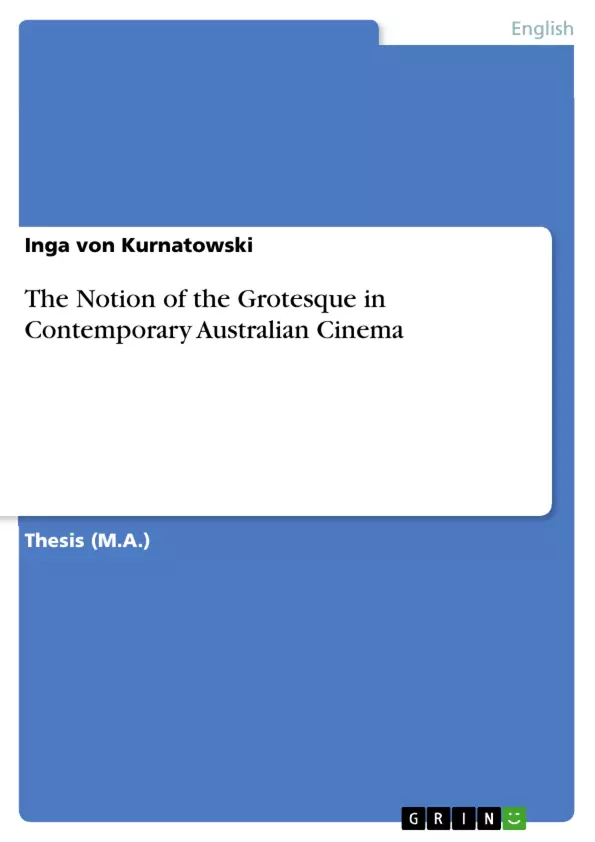Der Begriff „grotesk“ bezieht sich auf die Theorie des Karnival des russischen
Akademikers Michail Bachtin, der mittelalterliche Volkskultur und seine
Manifestationen in Literatur und Gesellschaft untersuchte. In seiner Studie
Rabelais and His World (1968) argumentiert Bachtin, dass die Befreiung „from
conventions and established truths“(Bachtin, in Danow, 1995, 34) während
des sozialen Ereignisses des Karnival in einer Inversion der sozialen
Strukturen und hegemonischen Kodes resultiert, womit eine Kritik an der
existierenden sozialen Ordnung ausgedrückt wird.
Diese Theorie des Grotesken ist in der Literatur- und Filmwissenschaft
zur Anwendung gekommen, da es dominante Repräsentationen von sozialen,
politischen und gesellschaftlichen Sturkturen umkehrt und unterminiert.
Innerhalb eines australischen Kontextes argumentiere ich, dass Filme wie
Sweetie (Jane Campion, 1989), Muriel’s Wedding (P.J. Hogan, 1994), The
Adventures of Priscilla – Queen of the Desert (Stephen Elliott, 1994), Metal Skin
(Geoffrey Wright, 1995), Chopper (Andrew Domenik, 1999) oder The Castle
(Robert Sitch, 1997) typisch australische Filme sind, da sie das Element des
Grotesken als einen definierenden „aesthetic and thematic trend“ (Rayner,
2000, 21) verwenden und sich so von den konventionellen Normen
Hollywoods absetzen. Die Figur des Grotesken ist also nicht nur ein visuelles
und narratives Stilelement, sondern auch ein dominantes und definierendes
Merkmal in der australischen Filmlandschaft.
Die Identifikation des Grotesken als gemeinsames Merkmal populärer
australischer Langfilme kann weiterführend als Beitrag zur Diskussion über
ein Australian National Cinema und seine identitätsstiftende Wirkung
verwendet werden.
Inhaltsverzeichnis (Table of Contents)
- 1 Introduction
- 2 Theorising Australian Cinema
- 2.1 Australian Cinema before the 1990s
- 2.2 Contemporary Australian Cinema
- 2.3 Making a National Cinema
- 3 Theorising the Grotesque
- 3.1 Bakhtin and the Theory of Carnival
- 3.2 Gender and the Grotesque Body
- 3.2.1 The Female Body
- 3.2.2 The Male Body
- 3.3 Grotesque Laughter
- 3.4 The Grotesque and Film
- 4 The Grotesque in Australian Cinema
- 4.1 The Grotesque Female
- 4.2 The Grotesque Male
- 4.3 The Grotesque Humour
- 4.4 The Grotesque Film Style
Zielsetzung und Themenschwerpunkte (Objectives and Key Themes)
This thesis investigates the phenomenon of the grotesque in contemporary Australian cinema. It explores the function of the grotesque as a defining element in Australian film, examining its narrative and visual manifestations, and its potential to contribute to the discussion about an Australian national cinema and its identity.
- The grotesque as a defining characteristic of contemporary Australian cinema.
- The theory of carnival and the grotesque, particularly in relation to Mikhail Bakhtin's work.
- The role of gender in the representation of the grotesque in Australian cinema.
- The relationship between the grotesque and the formation of an Australian national cinema.
- The impact of the grotesque on the cinematic style of Australian films.
Zusammenfassung der Kapitel (Chapter Summaries)
The first chapter introduces the topic of the grotesque in contemporary Australian cinema and establishes the context for the thesis.
Chapter 2 provides an overview of the development of Australian cinema, from its early days to the contemporary era, focusing on the emergence of a distinctive national style.
Chapter 3 delves into the theoretical framework for understanding the grotesque, examining Bakhtin's theory of carnival and its application to film.
Chapter 4 analyzes the manifestations of the grotesque in a range of contemporary Australian films, exploring how the grotesque operates in terms of character, humor, and cinematic style.
Schlüsselwörter (Keywords)
The primary focus of this thesis is on the concept of the grotesque in contemporary Australian cinema. Key terms and concepts include: Australian national cinema, carnival, Bakhtin, gender, film style, narrative, visual, and identity.
- Quote paper
- Magister Artium Inga von Kurnatowski (Author), 2005, The Notion of the Grotesque in Contemporary Australian Cinema, Munich, GRIN Verlag, https://www.grin.com/document/60072



